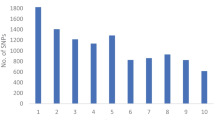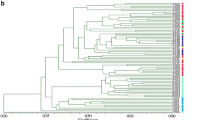Abstract
Knowledge about genetic variability of a crop allows for more efficient and effective use of resources in plant improvement programs. The genetic variation within temperate maize has been studied extensively, but the levels and patterns of diversity in tropical maize are still not well understood. Brazilian maize germplasm represents a very important pool of genetic diversity due to many past introductions of exotic material. To improve our knowledge of the genetic diversity in tropical maize inbred lines, we fingerprinted 85 lines with 569 AFLP bands and 50 microsatellite loci. These markers revealed substantial variability among lines, with high rates of polymorphism. Cluster analysis was used to identify groups of related lines. Well-defined groups were not observed, indicating that the tropical maize studied is not as well organized as temperate maize. Three types of genetic distance measurements were applied (Jaccard’s coefficient, Modified Rogers’ distance and molecular coefficient of coancestry), and the values obtained with all of them indicated that the genetic similarities were small among the lines. The different coefficients did not substantially affect the results of cluster analysis, but marker types had a large effect on genetic similarity estimates. Regardless of genetic similarity coefficient used, estimates based on AFLPs were poorly correlated with those based on SSRs. Analyses using AFLP and SSR data together do not seem to be the most efficient manner of assessing variability in highly diverse materials because the result was similar to using AFLPs alone. It was seen that molecular markers can help to organize the genetic variability and expose useful diversity for breeding purposes.



Similar content being viewed by others
References
Abdalla AM, Reddy OUK, El-Zik KM, Pepper AE (2001) Genetic diversity and relationships of diploid and tetraploid cottons revealed using AFLP. Theor Appl Genet 102:222–229
Barbosa AMM, Geraldi IO, Benchimol LL, Garcia AAF, Souza CL Jr, Souza AP (2003) Relationship of intra- and interpopulational tropical maize single cross hybrid performance and genetic distances computed from AFLP and SSR markers. Euphytica 130:87–99
Bernardo R (1993) Estimation of coefficient of coancestry using molecular markers in maize. Theor Appl Genet 85:1055–1062
Boppenmaier J, Melchinger AE, Seitz G, Geiger HH, Herrmann RG (1993) Genetic diversity for RFLPs in European maize inbreds. III. Performance of crosses within versus between heterotic groups for grain traits. Plant Breed 111:217–226
Chin ECL, Senior ML, Shu H, Smith JSC (1996) Maize simple repetitive DNA sequences: abundance and allele variation. Genome 39:866–873
Creste S, Tulmann Neto A, Figueira A (2001) Detection of single sequence repeat polymorphisms in denaturing polyacrylamide sequencing gels by silver staining. Plant Mol Biol Rep 19:299–306
Doldi M-L, Vollmann J, Lelley T (1997) Genetic diversity in soybean as determined by RAPD and microsatellite analysis. Plant Breed 116:331–335
Enoki H, Sato H, Koinuma K (2002) SSR analysis of genetic diversity among maize inbred lines adapted to cold regions of Japan. Theor Appl Genet 104:1270–1277
Garcia AAF, Benchimol LL, Barbosa AAM, Geraldi IO, Souza Jr CL, de Souza AP (2004) Comparison of RAPD, RFLP, AFLP and SSR markers for diversity studies in tropical maize inbred lines. Genet Mol Biol 27:579–588
Gethi JG, Labate JA, Lamkey KR, Smith ME, Kresovich S (2002) SSR variation in important US maize inbred lines. Crop Sci 42:951–957
Ghebru B, Schmidt RJ, Bennetzen JL (2002) Genetic diversity of Eritrean sorghum landraces assessed with simple sequence repeat (SSR) markers. Theor Appl Genet 105:229–236
Hahn V, Blankenhorn K, Schwall M, Melchinger AE (1995) Relationships among early European maize inbreds. III. Genetic diversity revealed with RAPD markers and comparison with RFLP and pedigree data. Maydica 40:299–310
Halldén C, Nilsson N-O, Rading IM, Säll T (1994) Evaluation of RFLP and RAPD markers in a comparison of Brassica napus breeding lines. Theor Appl Genet 88:123–128
Henderson ST, Petes TD (1992) Instability of simple sequence DNA in Saccharomyces cerevisiae. Mol Cell Biol 12:2749–2757
Hoisington D, Khairallah M, González-de-Léon D (1994) Laboratory protocols: CIMMYT applied molecular genetics laboratory, 2nd edn., CIMMYT, Mexico
Jaccard P (1908) Nouvelles recherches sur la distribution florale. Bull Soc Vaud Sci Nat 44:223–270
Lanza LLB, de Souza CL Jr, Ottoboni LMM, Vieira MLC, de Souza AP (1997) Genetic distance of inbred lines and prediction of maize single-cross performance using RAPD markers. Theor Appl Genet 94:1023–1030
Li C, Fatokun CA, Ubi B, Singh BB, Scoles GJ (2001) Determining genetic similarities and relationships among cowpea breeding lines and cultivars by microsatellite markers. Crop Sci 41:189–197
Lima MLA, Garcia AAF, Oliveira KM, Matsuoka S, Arizono H, de Souza CL Jr, de Souza AP (2002) Analysis of genetic similarity detected by AFLP and coefficient of parentage among genotypes of sugar cane (Saccharum spp.). Theor Appl Genet 104:30–38
Liu S, Cantrell RG, McCarty JC Jr, Stewart JMcD (2000) Simple sequence repeat-based assessment of genetic diversity in cotton race stock accessions. Crop Sci 40:1459–1469
Lu H, Bernardo R (2001) Molecular marker diversity among current and historical maize inbreds. Theor Appl Genet 103:613–617
Manifesto MM, Schlatter AR, Hopp HE, Suaréz EY, Dubcovsky J (2001) Quantitative evaluation of genetic diversity in wheat germplasm using molecular markers. Crop Sci 41:682–690
Mantel N (1967) The detection of disease clustering and a generalized regression approach. Cancer Res 27:209–220
Matsuoka Y, Mitchell SE, Kresovich S, Goodman M, Doebley J (2002) Microsatellites in Zea – variability, patterns of mutations, and use for evolutionary studies. Theor Appl Genet 104:436–450
Melchinger AE, Messmer MM, Lee M, Woodman WL, Lamkey KR (1991) Diversity and relationships among US maize inbreds revealed by restriction fragment length polymorphisms. Crop Sci 31:669–678
Meyer AS, Garcia AAF, Souza AP, Souza CL Jr (2004) Comparison of similarity coefficients used for cluster analysis with dominant markers in maize (Zea mays L). Genet Mol Biol 27:83–91
Miller MP (1997) TFPGA—Tools for population genetic analyses, vol 1.3. Northern Arizona University
Nei (1987) Molecular evolutionary genetics. Columbia University Press, New York
Oliveira KM, Laborda PR, Garcia AAF, Zagatto-Paterniani MEA, Souza AP (2004) Evaluating genetic relationships between tropical maize inbred lines by means of AFLP profiling. Hereditas 140:24–33
Paterniani MEAGZ, Sawazaki E, Dudienas C, Duarte AP, Gallo PB (2000) Diallel crossing among maize lines with emphasis on resistance to foliar diseases. Genet Mol Biol 23:381–385
Pejic I, Ajmone-Marsan P, Morgante M, Kozumplick V, Castiglioni P, Taramino G, Motto M (1998) Comparative analysis of genetic similarity among maize inbred lines detected by RFLPs, RAPDs, SSRs and AFLPs. Theor Appl Genet 97:1248–1255
Plaschke J, Ganal MW, Röder MS (1995) Detection of genetic diversity in closely related bread wheat using microsatellite markers. Theor Appl Genet 91:1001–1007
Priolli RHG, Mendes-Junior CT, Arantes NE, Contel EPB (2002) Characterization of Brazilian soybean cultivars using microsatellite markers. Genet Mol Biol 25:185–193
Reif JC, Melchinger AE, Xia XM, Warburton ML, Hoisington DA, Vasal SK, Srinivasan G, Bohn M, Frisch M (2003a) Genetic distance based on simple sequence repeats and heterosis in tropical maize populations. Crop Sci 43:1275–1283
Reif JC, Melchinger AE, Xia XM, Warburton ML, Hoisington DA, Vasal SK, Beck D, Bohn M, Frisch M (2003b) Use of SSRs for establishing heterotic groups in subtropical maize. Theor Appl Genet 107:947–957
Reif JC, Xia XM, Melchinger AE,Warburton ML, Hoisington DA, Beck D, Bohn M, Frisch M (2004) Genetic diversity determined within and among CIMMYT maize populations of tropical, subtropical, and temperate germplasm by SSR markers. Crop Sci 44:326–334
Rohlf FJ (1997) NTSYSpc - Numerical taxonomy and multivariate analysis system, v. 2.1. Exerter Publications, New York
Russell JR, Fuller JD, Macaulay M, Hatz BG, Jahoor A, Powell W, Waugh R (1997) Direct comparison of levels of genetic variation among barley accessions detected by RFLPs, AFLPs, SSRs and RAPDs. Theor Appl Genet 95:714–722
Sambrook J, Fritsch EF, Maniatis T (1989) Molecular cloning: a laboratory manual, 2nd edn. Cold Spring Harbor Laboratory Press, New York, pp B23
Senior ML, Murphy JP, Goodman MM, Stuber CW (1998) Utility of SSRs for determining genetic similarities and relationships in maize using an agarose gel system. Crop Sci 38:1088–1098
Smith JSC, Chin ECL, Shu H, Smith OS, Wall SJ, Senior ML, Mitchell SE, Kresovich S, Ziegle J (1997) An evaluation of the utility of SSR loci as molecular markers in maize (Zea mays L.): comparisons with data from RFLPs and pedigree. Theor Appl Genet 95:163–173
Smith JSC, Kresovich S, Hopkins MS, Mitchell SE, Dean RE, Woodman WL, Lee M, Porter K (2000) Genetic diversity among elite sorghum inbred lines assessed with simple sequence repeats. Crop Sci 40:226–232
Tivang JG, Nienhuis J, Smith OS (1994) Estimation of sampling variance of molecular marker data using the bootstrap procedure. Theor Appl Genet 89:259–264
Vos P, Hogers R, Bleeker M, Reijans M, van de Lee T, Hornes M, Fritjers A, Pot J, Peleman J, Kuiper M, Zabeau M (1995) AFLP: a new technique for DNA fingerprinting. Nucleic Acids Res 23:4407–4414
Warburton ML, Xianchun X, Crossa J, Franco J, Melchinger AE, Frisch M, Bohn M, Hoisington D (2002) Genetic characterization of CIMMYT inbred maize lines and open pollinated populations using large scale fingerprinting methods. Crop Sci 42:1832–1840
Wright S (1978) Evolution and the genetics of populations, vol. 4. Variability within and among natural populations. University of Chicago Press, Chicago
Acknowledgments
The authors wish to thank CAPES (Coordenação de Aperfeiçoamento de Pessoal de Nível Superior), FAPESP (Fundação de Amparo à Pesquisa do Estado de São Paulo) (00/11517-4) and CNPq (Conselho Nacional de Desenvolvimento Científico e Tecnológico) for the financial support during the development of this research. A.P.S. and A.A.F.G. received a research fellowship from CNPq. The authors would like to express their gratitude to Dr. James B. Holland and to Dr. David Hoisington who carefully revised the manuscript and kindly provided valuable comments on it.
Author information
Authors and Affiliations
Corresponding author
Additional information
Communicated by D. A. Hoisington
Rights and permissions
About this article
Cite this article
Laborda, P.R., Oliveira, K.M., Garcia, A.A.F. et al. Tropical maize germplasm: what can we say about its genetic diversity in the light of molecular markers?. Theor Appl Genet 111, 1288–1299 (2005). https://doi.org/10.1007/s00122-005-0055-7
Received:
Accepted:
Published:
Issue Date:
DOI: https://doi.org/10.1007/s00122-005-0055-7




